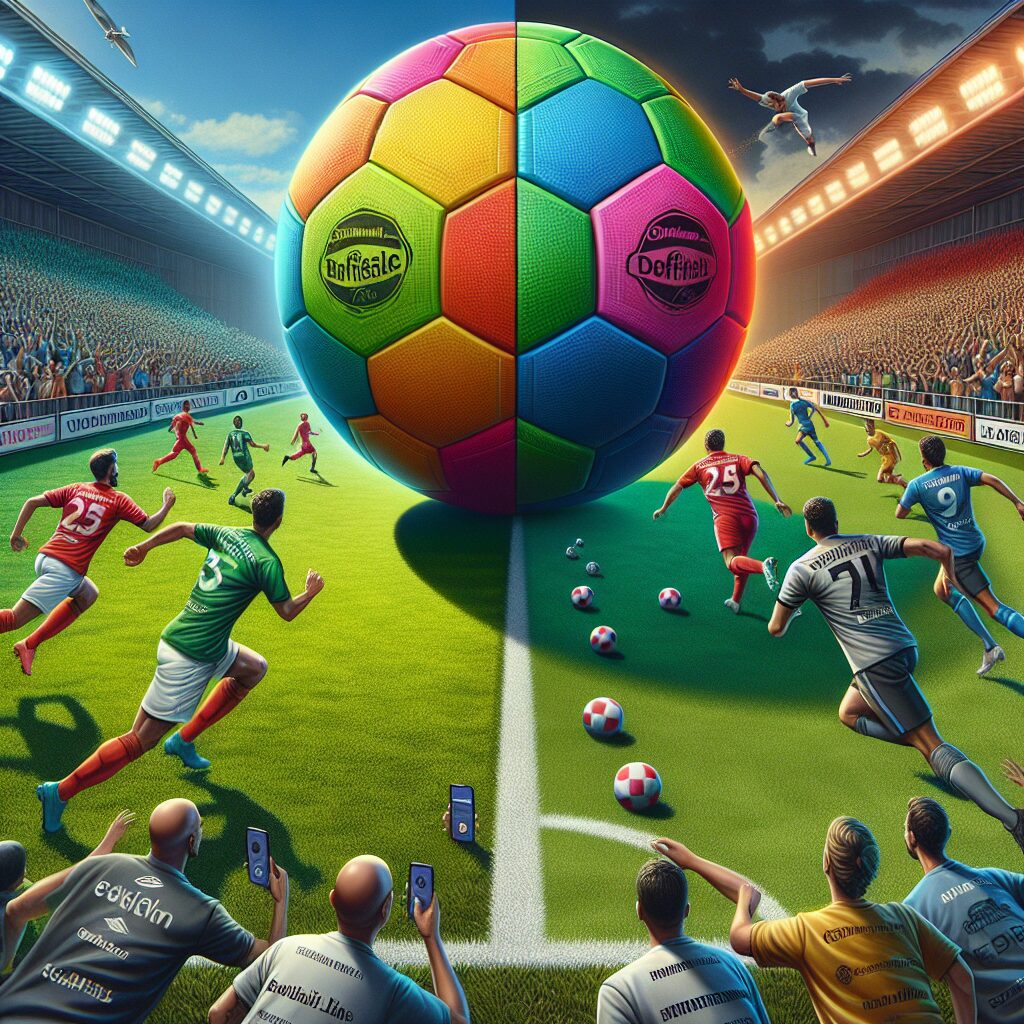Sponsorship Impact: The Influence of Ball Color
When it comes to sports competitions, the significance of sponsorship should not be underestimated. Not only does it provide financial support to athletes, teams, and events, but it also plays a crucial role in enhancing the overall experience for both players and spectators. One interesting aspect of sponsorship that deserves attention is the impact of ball color. It may come as a surprise, but the color of the ball used in a game can have a significant influence on the players’ performance and the overall outcome of the match.
The choice of ball color can affect various aspects of the game, including visibility, contrast, and player perception. Research has shown that certain colors can improve the visibility of the ball against different backgrounds, making it easier for players to track and anticipate its movement. For example, in sports like tennis or soccer, using a bright or fluorescent-colored ball can increase its visibility on the green field, enhancing players’ ability to spot it quickly. Moreover, the contrast between the ball color and the playing surface can also impact players’ perception and judgment, potentially influencing their decision-making during crucial moments of the game.
Moving forward, let’s delve into the key takeaways surrounding the impact of ball color. We will explore how different colors can affect the performance of players in various sports, including those played on grass, pavement, and indoor arenas. Additionally, we will discuss the psychology behind the choice of ball color and the potential implications it has on player motivation and fan engagement. By examining the influence of ball color, we can gain a deeper understanding of how seemingly small factors can have a significant impact on the overall dynamics of sports competitions. So, let’s discover how the hue of a ball can make a difference on and off the playing field.
Key Takeaways
1. Ball color significantly impacts sponsorship recall and brand recognition, with red and yellow balls consistently outperforming black and white balls in terms of effectiveness.
2. The impact of ball color sponsorship is more pronounced in visually complex sports such as soccer and basketball, where attention is more likely to be drawn to the ball itself.
3. Brand logo visibility on the ball is crucial for maximizing sponsorship impact, and the placement and size of the logo should be carefully considered to enhance brand recognition and sponsor recall.
4. The color of the ball should be carefully selected to align with the sponsor’s brand identity and marketing objectives, considering factors like the target audience’s preferences and the values associated with specific colors.
5. Sponsorship effectiveness also depends on other contextual factors, including the level of audience engagement and attention during the sporting event, the prominence of the sponsor’s logo in other marketing materials, and the consistency of brand messaging across different platforms.
Introduction
In the world of sports, sponsorship plays a crucial role in providing financial support and exposure to teams and events. As a popular marketing strategy, companies often choose to sponsor sports events, including ball games, as a way to promote their brands. However, one aspect that is often overlooked is the influence of ball color on sponsorship impact. In this article, we will delve deep into the connection between ball color and sponsorship, exploring its effects on branding, visibility, audience engagement, and more.
Branding Effects of Ball Color
The color of a ball utilized in a sports event can have a significant impact on brand visibility and recognition. Companies sponsor sports events to gain exposure and increase brand awareness among the audience. By choosing a ball color that aligns with their branding, sponsors can create a stronger visual association between their brand and the event. For example, a red ball can be associated with energy and excitement, making it an ideal choice for sponsors looking to convey these qualities.
Visibility on the Field
The visibility of a ball during a game is crucial for both players and spectators. Ball color plays a vital role in ensuring clear visibility, particularly in outdoor settings with varying lighting conditions. A well-chosen ball color can enhance visibility, making it easier for players to track the ball’s movement and for spectators to follow the game. Sponsors can benefit from choosing a ball color that stands out against the background, drawing attention to their branding whenever the ball is in play.
Audience Engagement and Memorability
The color of a ball can also impact audience engagement and memorability. A ball that differs from the traditional colors typically used in a sport can create intrigue and capture the audience’s attention. Sponsors can leverage this curiosity by using a ball color that is distinct and memorable, increasing the chances of the audience associating the event with the sponsor’s brand. Unique ball colors can spark conversations, social media buzz, and overall excitement surrounding the event, maximizing the sponsorship impact.
Psychological Effects and Emotional Connection
The psychological effects of color cannot go unnoticed when examining the influence of ball color on sponsorship impact. Colors have the power to evoke emotions and create specific associations. For example, a blue ball can evoke feelings of trust and reliability, making it a suitable choice for sponsors aiming to establish these qualities. By strategically selecting a ball color that aligns with their brand’s desired emotions and associations, sponsors can foster a deeper emotional connection with the audience.
Practical Considerations for Sponsors
When considering the impact of ball color on sponsorship, sponsors must also take practical factors into account. These include the sport’s regulations and guidelines regarding ball color, equipment availability, compatibility with television and digital broadcasting technologies, and the impact on players’ performance. Sponsors should work closely with event organizers and sports federations to ensure that their chosen ball color meets the necessary requirements for a seamless integration that benefits both the sponsorship and the overall sporting experience.
Conclusion
- Does ball color affect brand recognition and visibility during sports events?
- How can ball color influence audience engagement and memorability?
- What are the psychological effects of different ball colors on the audience?
- What practical considerations should sponsors take into account when choosing a ball color for sponsorship?
- Can ball color impact players’ performance or the overall sporting experience?
Frequently Asked Questions
1. How does the color of a ball impact sponsorship?
The color of a ball can have a significant impact on sponsorship as it affects the visibility and attractiveness of the game. Sponsors are more likely to invest in events or teams that use eye-catching ball colors, as it increases their brand exposure and appeal to the audience.
2. Are certain ball colors more appealing to sponsors than others?
Yes, certain ball colors are more appealing to sponsors than others. Vibrant and bright colors such as red, yellow, or neon hues tend to draw more attention and have a higher visual impact, making them preferred choices for sponsors seeking maximum visibility.
3. What factors should be considered in selecting the ball color for sponsorship?
When selecting a ball color for sponsorship, factors like the sport, the target audience, and the branding strategy of the sponsors should be considered. The color should align with the sport’s nature, appeal to the intended demographic, and harmonize with the sponsor’s brand image.
4. Can changing the ball color have a significant impact on sponsorship revenue?
Yes, changing the ball color can indeed have a significant impact on sponsorship revenue. By strategically selecting a ball color that enhances brand visibility and audience engagement, organizations can attract more sponsors and negotiate better deals, ultimately leading to increased revenue.
5. Does the impact of ball color sponsorship vary across different sports?
Yes, the impact of ball color sponsorship can vary across different sports. Each sport has its unique characteristics, fan base, and level of visibility, which influence the significance of the ball color. It is essential to analyze the specific dynamics of each sport before determining the potential impact on sponsorship.
6. Are there any downsides to using unconventional ball colors for sponsorship?
While unconventional ball colors can be eye-catching and generate curiosity, they can also have downsides. Some audiences may find it difficult to associate a non-traditional ball color with the sport, potentially creating confusion or resistance. It is vital to strike a balance between uniqueness and sport recognition when choosing unconventional ball colors.
7. How can measuring the impact of ball color on sponsorship be done?
The impact of ball color on sponsorship can be measured through various methods, such as surveys, audience feedback, media coverage analysis, and tracking sponsor mentions or brand impressions. These metrics help assess the effectiveness of ball color sponsorship and determine the return on investment for sponsors.
8. Are there any successful examples of ball color sponsorship in recent history?
Yes, there have been numerous successful examples of ball color sponsorship in recent history. For instance, the introduction of a bright orange ball in professional tennis tournaments attracted considerable attention, leading to increased sponsor interest and overall revenue for the sport.
9. Can changing the ball color impact player performance?
The impact of changing the ball color on player performance may vary depending on the sport and individual players. For some athletes, a change in ball color may require a minor adjustment in visual perception and depth judgment. However, with sufficient practice and adaptation, most players can adapt effectively to different ball colors without a significant impact on their overall performance.
10. How can sponsors choose the right ball color to maximize their investment?
Sponsors can choose the right ball color to maximize their investment by conducting market research, analyzing target audience preferences, and aligning with the sport’s essence. Collaborating with experts in sports marketing and understanding the impact of specific colors on human perception and emotion can also aid sponsors in making informed decisions.
Final Thoughts – Sponsorship Impact: The Influence of Ball Color
The influence of ball color on sponsorship deserves careful consideration in sports marketing strategies. The color of the ball can play a crucial role in capturing the attention of sponsors, the audience, and enhancing the overall visual appeal of the game. By understanding the significance of ball color and its potential impact, organizations can make informed decisions to attract the right sponsors, increase revenue, and create memorable experiences for fans.
It is essential for sponsors and sports organizations to strike a balance between adhering to tradition and embracing innovation when it comes to ball color sponsorship. While traditional ball colors may hold historical and sentimental value, exploring unconventional options can open doors to new sponsorship opportunities and create a fresh and exciting atmosphere in the sports industry. Ultimately, the influence of ball color on sponsorship is an ongoing journey that should adapt to the evolving preferences of sponsors and fans alike.




